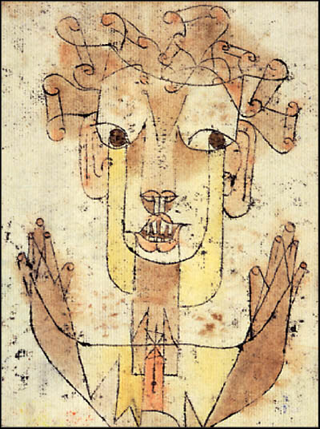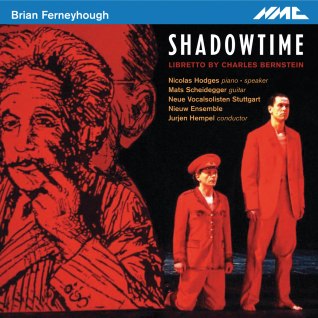Walter Benjamin and Klee’s Angelus Novus
Paul Klee’s 1920 painting Angelus Novus, which Benjamin compared to “the angel of history”
IX
My wing is poised to beat
but I would gladly return home
were I to stay to the end of days
I would still be this forlorn
— Gershom Scholem, “Greetings from Angelus” [tr. Richard Sieburth]
There is a painting by Klee called Angelus Novus. It shows an angel who seems about to move away from something he stares at. His eyes are wide, his mouth is open, his wings are spread. This is how the angel of history must look. His face is turned toward the past. Where a chain of events appears before us, he sees on single catastrophe, which keeps piling wreckage upon wreckage and hurls it at his feet. The angel would like to stay, awaken the dead, and make whole what has been smashed. But a storm is blowing from Paradise and has got caught in his wings; it is so strong that the angel can no longer close them. This storm drives him irresistibly into the future to which his back is turned, while the pile of debris before him grows toward the sky. What we call progress is this storm. /1/
/1/The ninth thesis from Walter Benjamin 1940 work, “On the Concept of History,” Gesammelte Schriften I, 691-704. SuhrkampVerlag. Frankfurt am Main, 1974. Translation: Harry Zohn, from Walter Benjamin, Selected Writings, Vol. 4: 1938-1940 (Cambridge: Harvard University Pres, 2003), 392-93. Sholem’s poem on the Klee painting was written for Benjamin’s twenty-ninth birthday — July 15, 1921. Sieburth’s translation is from Gershon Scholem, The Fulnness of Time: Poems (Jerusalem: Ibis Editions, 2003).
WEJ: From a note on U. At Buffalo Green Integer web site for (somewhat improbably?) an opera:
“Brian Ferneyhough’s opera Shadowtime, setting Charles Bernstein’s poetic and complex libretto of seminal 20th-century philosopher Walter Benjamin’s last days and a phantasmagorical descent to the underworld. In its seven scenes, Shadowtime explores some of the major themes of Benjamin’s work, including the intertwined natures of history, time, transience, timelessness, language, and melancholy; the possibilities for a transformational leftist politics; the interconnectivity of language, things, and cosmos; and the role of dialectical materiality, aura, interpretation, and translation in art. Beginning on the last evening of Benjamin’s life, Shadowtime projects an alternative course for what happened on that fateful night.
Opening onto a world of shades, of ghosts, of the dead, Shadowtime inhabits a period in human history in which the light flickered and then failed.”
In the opera libretto is a summary of the plot that contains a clear reference to Klee’s painting. From the description of scene 7:
“Stelae for Failed Time” has two over-lapping layers. The first is a reflection on time and uncertainty in the context of historical recrimination and erasure:
“I back away
helpless, my
eyes fixed.
This is my task:
to imagine no wholes
from all that has been smashed.”



